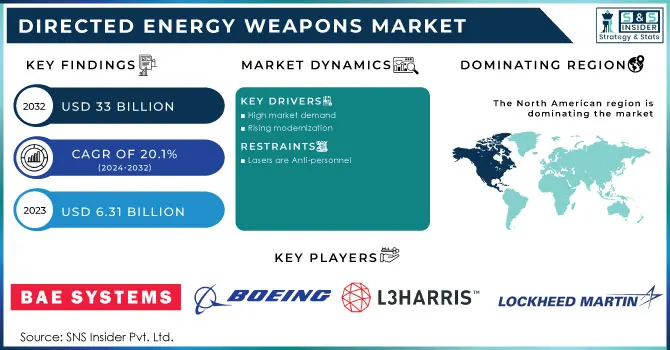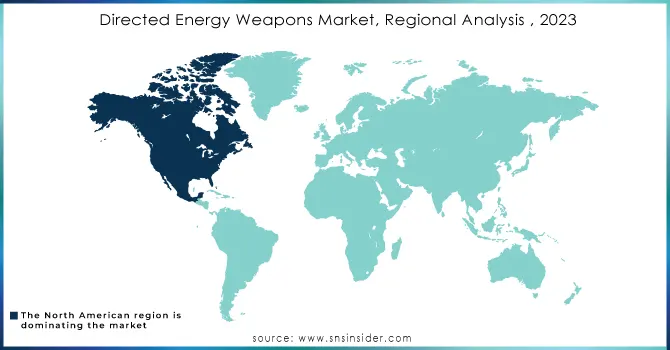Directed Energy Weapons Market Report Scope & Overview:

To get more information on Directed Energy Weapons Market - Request Free Sample Report
The Directed Energy Weapons Market Size was recorded at USD 6.31 billion in 2023 and is expected to reach USD 33 billion by 2032, growing at a CAGR of 20.1% over the forecast period 2024-2032
The growing demand for a laser especially for the navy, regulations, and legal impact of DEWs have resulted in the growth of the targeted energy weapons market. In addition, the need for accuracy has added to the popularity of the market. However, the arms transfer policy and insufficient funding limit the growth of the market to a large extent. On the other hand, rising international security costs and technological advances are expected to provide greater opportunities for key market players.
A weapon that emits concentrated energy and can transfer that energy to the target is called directed nuclear power. The targeted arms market is known for making very strong beams. They mainly use a single vision system to track a target or simply focus on that target. Lasers are considered to be the most advanced type of DEW weapon. In addition, these rays can be easily redirected through mirrors to damage invisible objects in the source.
Growing local conflicts and the growing need for advanced military equipment in warfare systems are improving the global market for targeted weapons. In addition, the growing investment of a few defense and military organizations in developing existing infrastructure to improve national security also accelerates the market growth. In addition, the increase in threats from hypersonic weapons, especially missiles, results in the need for more powerful weapons of mass destruction in the missile trajectory. Apart from this, the increasing adoption of specific nuclear weapons to protect civilians in many chemicals, biological, radiological, and nuclear emergencies also strengthen market growth. Apart from this, the emergence of various military-based UAVs and drones combined with targeted power weapons to provide precise long-range accuracy and remote operation is driving the global market. In the years to come, the introduction of a few advanced solutions, such as high-energy lasers for the deterrence of cruise missiles, will continue to stimulate the global nuclear power market.
MARKET DYNAMICS
KEY DRIVERS
-
High market demand
-
Rising modernization
RESTRAINTS
-
Lasers are Anti-personnel
OPPORTUNITIES
-
Enhancing R&D
-
High accuracy
CHALLENGES
-
Rising barrier in DEW system
-
Complexity of design
THE IMPACT OF COVID-19
The pandemic-affected year revealed an unchanged position of contractors, who are now better positioned and thus immune because they will most likely not feel the impact of COVID-19 in the short- to mid-term. While manufacturing is slow for the same reasons that aircraft manufacturing is, demand over the next two years is unlikely to be influenced because resources for these projects were delegated prior to the pandemic, and the projects are critical to national security. Because nations tended to rely on domestic producers for essential military equipment, the defense industry was shielded from global shocks. The COVID-19 pandemic has wreaked havoc on the economies of countries all over the world. Directed energy weapon manufacturing, including systems, subsystems, and components, has also been impacted. Although directed energy weapons are critical for national integration, supply chain disruptions have temporarily halted their production processes. The level of COVID-19 exposure, the level at which manufacturing operations are running, and import-export regulations, among other factors, all influence the resumption of manufacturing activities. While businesses may still accept orders, delivery schedules may not be fixed.
MARKET ESTIMATIONS
By Application
Because of the increased employment of directed energy weapons by military forces, the military is the largest segment. Throughout the projected period, the homeland security application is expected to increase at a rapid CAGR.
By Platform
The ground-based category is expected to dominate the overall directed energy weapon market share over the forecast period.
By Type
Throughout the forecast period, the lethal weapon segment is expected to grow at a rapid pace. The massive R&D funding, particularly in lethal weapons, is one of the key factors expected to propel the directed energy weapons market forward.
By Technology
The high-energy laser technology segment is expected to be the most important during the review period. As these drones can spend more time in the air, the high-power microwave technology segment of the directed energy weapon market is growing at the fastest rate.
Regional Analysis:
The North American region will take the lead in military development. Because of technological advancements in warfare platforms and collective defense budgets, North America is expected to dominate the market.
The majority of companies operating in the directed energy weapons market are based in the United States, further cementing the region's overall control of the global market. Military Spending to Strengthen APAC The Asia Pacific region is the fastest growing region in the directed energy weapon market, owing to rising terrorism incidents and border threats.

Need any customization research on Directed Energy Weapons Market - Enquiry Now
KEY PLAYERS
The Key Players are BAE Systems PLC, The Boeing Company, L3Harris Technologies, Inc., Lockheed Martin Corporation, Moog Inc., Northrop Grumman Corporation, Quinetiq Group PLC, Raytheon Company, Rheinmetall AG, Textron Inc & Other Players
| Report Attributes | Details |
|---|---|
| Market Size in 2023 | US$ 6.31 Billion |
| Market Size by 2032 | US$ 33 Billion |
| CAGR | CAGR of 20.1% From 2024 to 2032 |
| Base Year | 2023 |
| Forecast Period | 2024-2032 |
| Historical Data | 2020-2022 |
| Report Scope & Coverage | Market Size, Segments Analysis, Competitive Landscape, Regional Analysis, DROC & SWOT Analysis, Forecast Outlook |
| Key Segments | • by Technology (High energy laser, High power radio frequency (microwave weapons), Electromagnetic weapons, Sonic weapons) • by Application (Homeland Security, Military) • by Platform (Land, Airborne, Naval, Space) • by Type (Lethal Weapon, & Non-Lethal Weapon) |
| Regional Analysis/Coverage | North America (USA, Canada, Mexico), Europe (Germany, UK, France, Italy, Spain, Netherlands, Rest of Europe), Asia-Pacific (Japan, South Korea, China, India, Australia, Rest of Asia-Pacific), The Middle East & Africa (Israel, UAE, South Africa, Rest of Middle East & Africa), Latin America (Brazil, Argentina, Rest of Latin America) |
| Company Profiles | BAE Systems PLC, The Boeing Company, L3Harris Technologies, Inc., Lockheed Martin Corporation, Moog Inc., Northrop Grumman Corporation, Quinetiq Group PLC, Raytheon Company, Rheinmetall AG, Textron Inc |
| Key Drivers | • High market demand • Rising modernization |
| RESTRAINTS | • Lasers are Anti-personnel |

